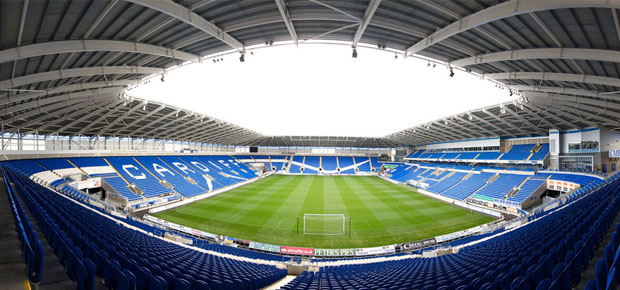The Cardiff City Stadium (Welsh: Stadiwm Dinas Caerdydd) is a football stadium in the Leckwith area of Cardiff, Wales. It is the home of Cardiff City Football Club and the Wales national football team.
Following expansion of the Ninian Stand in July, 2014; the stadium now officially holds 33,280 supporters - meaning that it is the 24th largest stadium in the United Kingdom in terms of capacity. The stadium replaced Ninian Park as Cardiff City's home ground in 2009, and is managed by Cardiff City Stadium Ltd., which is owned by Cardiff City Football Club Holdings Ltd. It also hosted the home matches of the Cardiff Blues rugby union team until the 2011–12 season, although originally the Blues had a lease until 2029.
After the Millennium Stadium, it is the second largest stadium in Cardiff and in Wales. The stadium is part of the Leckwith development, which also includes the Cardiff International Sports Stadium. A branded sponsor name will be assigned as and when the naming rights are sold. The stadium was officially opened on 22 July 2009, with Cardiff City playing a friendly match against Celtic.
Overview
The stadium was built on the site of the former Cardiff Athletics Stadium and forms part of the larger Leckwith development. The 60-acre (240,000 m2) development was estimated to cost £100m and include construction of the following:
- A 28,018 seater stadium
- A new athletics stadium (Cardiff International Sports Stadium)
- 470,000 sq ft (44,000 m2) retail development between 13 major retailers (Capital Retail Park)
- A housing development on the site of Ninian Park
- Brand new 70 room hotel with bar & restaurant
- A new road system
- HistoryBackground to construction
- First mooted as a long term target by former owner Sam Hammam, the new stadium first gained public approval after a meeting between Hammam and then Cardiff Lord Mayor Russell Goodway in January 2002, giving the club 12 months to agree a planning and business plan. In November 2002 the club and Cardiff Council signed an outline agreement for the development, subject to later agreement for outline planning permission.In March 2003, stories began to emerge that the Chief Executive of the Millennium Stadium wanted Cardiff City to use their stadium instead, and saw no viable plan for two 50,000+ seat capacity stadium in the Welsh capital. This was increased in light of Cardiff City's promotion to the Championship in May 2003 with local fears over traffic and access problems.However, on 20 August 2003 Cardiff councillors gave unanimous approval to the stadium plans, although expressed concerns over the need and scale of the retail development but understood its need to fund the stadium. On 9 September 2003 the Welsh Assembly gave approval to the plan.In April 2004, Cardiff Council gave the first phase covering the stadium with a capacity of 30,000 seats and new athletics track approval. The next phase was held up by various legal and technical delays from November 2004 to January 2005, when the council gave approval to three detailed plans for the retail development, subject to agreement of suitable underlying business plans.Although development could have then started in May 2005, the underlying need for seed financing revealed the financial status of Cardiff City football club as poor, with over £30 million of debt and the need to sell star player and club captain Graham Kavanagh to Wigan Athletic F.C. in March 2005. It was also revealed that players and staff had not been paid for a month as the club struggled to honour a wage bill believed to be £750,000 a month, while auditors were looking at possible cutbacks. On 1 March 2005 the club delayed the development until at least July 2005.After a 1–0 home loss to Sheffield United and a mobbing by fans, on 6 March 2005 Hammam apologised to fans, and released club accounts which showed club debt at March 2004 at £29.6 million.After a summer sale of players, the entry of former Leeds United chairman Peter Ridsdale and numerous rumours, the development was given a 90-day time period by Cardiff Council from 31 December 2005 to finalise the underlying business plan. On 31 January 2006 the developers secured Asda as the lead retailer of the new development, which enabled the final funding of the stadium to start. This allowed the council timetable to extend by four months to September 2006.On 24 October 2006 Laing O'Rouke won the contract to develop the 30,000 seat stadium, which Ridsdale stated would be ready for December 2008. On 27 November 2006 Cardiff Council approved the business plan for the stadium, and granted a 125-year lease for the land on which the stadium was to sit upon, allowing the final planning approval to be gained from the council authority and the office of the Deputy Prime Minister.In March 2007, the stadium plans were altered to allow construction to begin as soon as possible. To minimise construction costs, the 30,000 capacity was reduced to 25,000 by removing three-quarters of the second tier of seating, however the plans allow the option of completing the second tier to reach the 30,000 capacity if required. The former chairman of Cardiff City, Steve Borley, said in March 2008 that "We are working to raise the capacity and right now it stands at 26,830. The task is to raise that even further, and we believe it could be almost 28,000 when the stadium opens."When work finally commenced Peter Ridsdale stated that he expected the stadium to be ready by Christmas 2008 but it was finally completed in May 2009. Although some believe this slight delay was caused by Cardiff City's ongoing legal action with Langston, it was actually caused by unexpectedly poor weather during the summer of 2007.












